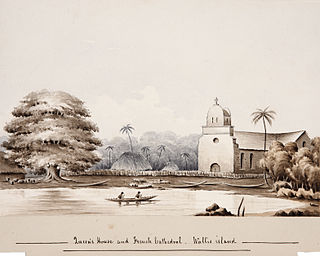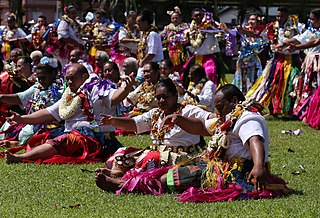Related Research Articles

Wallis and Futuna, officially the Territory of the Wallis and Futuna Islands, is a French island collectivity in the South Pacific, situated between Tuvalu to the northwest, Fiji to the southwest, Tonga to the southeast, Samoa to the east, and Tokelau to the northeast.

The official flag of Wallis and Futuna is the French national flag, as it is a French territory. Wallis and Futuna has a locally used unofficial flag which bears the French flag in the canton.

The uvea, also called the uveal layer, uveal coat, uveal tract, vascular tunic or vascular layer is the pigmented middle layer of the three concentric layers that make up an eye, precisely between the inner retina and the outer fibrous layer composed of the sclera and cornea.

Politics of Wallis and Futuna takes place in a framework of a parliamentary representative democratic French overseas collectivity, whereby the President of the Territorial Assembly is the head of government, and of a multi-party system. Executive power is exercised by the government.
The Samoic–Outlier languages, also known as Samoic languages, are a purported group of Polynesian languages, encompassing the Polynesian languages of Samoa, Tuvalu, American Samoa, Tokelau, Wallis and Futuna, and Polynesian outlier languages in New Caledonia, the Solomon Islands, Vanuatu, Papua New Guinea, and the Federated States of Micronesia. The name "Samoic-Outlier" recognizes Sāmoan.

Ouvéa or Uvea is a commune in the Loyalty Islands Province of New Caledonia, an overseas territory of France in the Pacific Ocean. The settlement of Fayaoué [faˈjawe], on Ouvéa Island, is the administrative centre of the commune.

Wallis is a Polynesian atoll/island in the Pacific Ocean belonging to the French overseas collectivity of Wallis and Futuna. It lies north of Tonga, northeast of Fiji, east-northeast of the Hoorn Islands, east of Fiji's Rotuma, southeast of Tuvalu, southwest of Tokelau and west of Samoa. Its area is almost 100 km2 (39 sq mi) with 8,333 people. Its capital is Mata Utu. Roman Catholicism is the predominant religion. Its highest point is Mount Lulu Fakahega. Wallis is of volcanic origin with fertile soil and some remaining lakes. Rainfall is plentiful.

Mata Utu is the capital city of Wallis and Futuna, an overseas collectivity of France. It is located on the island of Uvéa (ʻUvea), in the district of Hahake, of which it is also the capital. It is one of two ports in Wallis and Futuna, the other being at Leava on Futuna. Hihifo Airport, the main airport serving the island and city, is 5.6 kilometres (3.5 mi) to the northwest. Its population was 1,029 in 2018, up from 815 in 1998.

Ouvéa Island or Uvea Island is one of the Loyalty Islands, in the archipelago of New Caledonia, an overseas territory of France in the Pacific Ocean. The island is part of the commune (municipality) of Ouvéa, in the Loyalty Islands Province of New Caledonia.
Wallisian, or ʻUvean, is the Polynesian language spoken on Wallis Island. The language is also known as East Uvean to distinguish it from the related West Uvean language spoken on the outlier island of Ouvéa near New Caledonia. The latter island was colonised from Wallis Island in the 18th century.
West Uvean is a Polynesian outlier language spoken on the island of Ouvéa, in the Loyalty island group of New Caledonia, and in the capital of Nouméa. It has long been in contact with Iaai, the Southern Oceanic language also spoken on the same island. Consequently, four vowels have been added, and the syllable structure has become complex, allowing for final consonants.

Cathedral of Our Lady of the Assumption, also known as Matâ'Utu Cathedral, is a Roman Catholic cathedral, and a national monument of France, located in the town of Mata Utu on Uvea, in Wallis and Futuna. It is a dominant edifice in downtown Mata-Utu town, capital of Wallis Island. It bears the royal insignia of Wallis, a Maltese cross between its towers. The cathedral is also known as the "Our Lady of Good Hope Cathedral". It is the seat of Bishop Susitino Sionepoe.
Takala was a Wallisian customary chief of the Mua District who ruled as King of Uvea from 1831 to 1832. A descendant of King Vehi'ika, he took advantage of the arrival of a Hawaiian merchant, Siaosi Manini, to overthrow king Soane-Patita Vaimua Lavelua. After Manini's defeat at the end of January 1832, he lost his title. He died a few months later after another violent altercation with British and American sailors.
Soane-Patita Vaimua Lavelua was a king of Uvea in the 19th century. He was named king in 1829 at the age of thirty) and reigned until his death in 1858. During his reign, Marist missionaries landed in Wallis in 1837 and converted the population. He then became the first Lavelua baptized Catholic and took the name Jean-Baptiste, in Wallisian "Soane Patita". He died at almost sixty years of age of pneumonia on 21 November 1858. His sister Falakika Seilala succeeded him only a few weeks later, on 5 December 1858.
Hunayn ibn Ishaq's Book of the Ten Treatises of the Eye is a 9th-century theory of vision based upon the cosmological natures of pathways from the brain to the object being perceived. This ophthalmic composition is heavily derived from Galen's De placitis Hippocratis at Platonis and De usu partium, both in terms of the anatomy and physiology being described. Hunayn's triumph comes from the systematic presentation of the parts of eye and the subsequent additions he made to the cosmological aspects of the work. Its early translation to Latin also provided a means for medieval ophthalmologists in the West to come into contact with the work of Galen.

ʻUvea is one of the three official chiefdoms of the French territory of Wallis and Futuna in Oceania in the South Pacific Ocean.

In Uvea (Wallis) and Futuna, dances play a major cultural role. One sees dance in fakahaha'aga (festivals), to'oto'oga, or just for pure pleasure. In Uvea, the term faiva is used for dance, whereas the term mako is used. In Uvea and Futuna there is a katoaga which is only celebrated with the visit of chiefs and if lucky, with the Lavelua (King). As the years go by, dance and culture is still alive and well in Uvea and Futuna. The normal fakapale is given to the dancers for their magnificent dance. The following dances of Uvea and Futuna below are just some of the dances, or are the main dances seen in Wallisian and Futunan culture.

Wallis and Futuna, an overseas territory of France in Oceania has a rich Polynesian culture that is very similar to the cultures of its neighbouring nations Samoa and Tonga. The Wallisian and Futunan cultures share very similar components in language, dance, cuisine and modes of celebration.
Mulitoto was a King of Uvea, who reigned for less than a year in 1829. He was preceded by Toifale. He lived in Ha'afuasia. Very old, he died during the year of his reign and was buried in Tokatafa. He was succeeded by Soane-Patita Vaimua Lavelua.
References
- ↑ Bernard Vienne et Daniel Frimigacci, « Les fondations du royaume de ’Uvea. Une histoire à revisiter », Journal de la Société des Océanistes, nos 122-123, 1er décembre 2006, p. 27–60 (ISSN 0300-953x, DOI 10.4000/jso.529